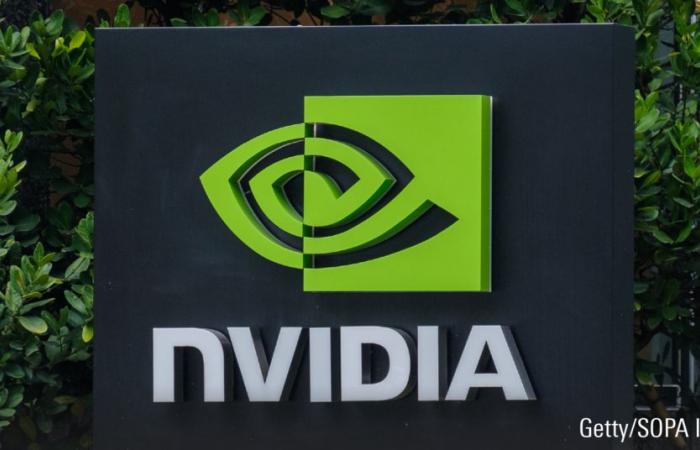Nvidia NVDA is scheduled to report third-quarter results on November 20. Here’s Morningstar’s take on what to expect from Nvidia’s earnings and stock.
Estimated fair value of Nvidia
With its 2-star rating, we believe Nvidia stock is overvalued relative to our long-term fair value estimate of $105 per share, implying an equity value of approximately $2.5 trillion . Our fair value estimate implies an adjusted price/earnings multiple of 37 times for fiscal year 2025 (ending January 2025, or actually calendar year 2024) and a forward adjusted price/earnings multiple of 27 times for fiscal year 2026.
Our Fair Value Estimate, and Nvidia’s Price/Fair Value, will be determined by its prospects in data center and AI GPUs, for better or worse. Nvidia’s DC business has already achieved exponential growth, growing from $3 billion in fiscal 2020 to $15 billion in fiscal 2023 and more than tripling to $47.5 billion. dollars in fiscal 2024. DC revenue appears to be supply constrained, and we believe Nvidia will continue to steadily increase revenue over each of the four quarters of the 2025 financial year, as the offer expands. Based on Nvidia’s strong guidance for fiscal 2025, we estimate that DC revenue will grow 133% to $111 billion in fiscal 2025. We model a compound annual growth rate by 23% for the next three years, as we expect strong growth in data center capital spending by large enterprises and cloud computing customers. We think it’s reasonable that Nvidia faces an inventory correction or a pause in AI demand in the medium term. Excluding this one-year blip that we model, we forecast average annual DC growth of 10% and consider this to be a reasonable long-term growth rate as AI matures .
Learn more about Nvidia’s fair value estimation.
Competitive bulwark
We give Nvidia a broad competitive bulwark rating, thanks to the intangible assets around its graphics processors and, increasingly, the switching costs around its proprietary software, like its Cuda platform for AI tools, which enables developers to use the firm’s GPUs to build AI models.
Nvidia was an early leader and designer of GPUs, originally developed to offload graphics processing tasks to PCs and gaming consoles. The company has established itself as the undisputed leader in the GPU market discreet (more than 80% market share, according to Mercury Research).
We attribute this leadership to the intangible assets associated with GPU design, as well as the associated software, frameworks, and tools that developers need to work with these GPUs. In our opinion, recent introductions such as ray-tracing technology and the use of AI tensors in gaming applications are signs that Nvidia has not lost its leadership position in the GPU space. A quick analysis of GPU pricing in gaming and AI shows that the firm’s average selling prices can often be twice as high as those of its closest competitor, Advanced Micro Devices AMD.
Financial strength
Nvidia enjoys excellent financial health. As of April 2024, the company held $31.4 billion in cash and investments, compared to $9.7 billion in short- and long-term debt. Semiconductor companies tend to hold large cash balances to help them weather chip industry cycles. In periods of slowdown, they thus have room to maneuver and flexibility allowing them to continue to invest in research and development, which is necessary to maintain their competitive and technological position. Nvidia’s dividend is virtually insignificant compared to its financial health and future prospects, and most of the company’s distributions to shareholders come in the form of stock buybacks.
Risk and uncertainty
We give Nvidia a Morningstar Uncertainty Rating of Very High. In our view, Nvidia’s valuation will be tied to its ability to grow in the data center and AI sectors, for better or worse. Nvidia is an industry leader in GPUs used in training AI models, while capturing much of the demand for chips used in AI inference workloads (which involves running a model to make a prediction or outcome).
We see a lot of technology leaders vying for Nvidia’s leadership position in the AI space. We believe it is inevitable that major large-scale solution providers, such as Amazon’s AWS, Microsoft, Google and Meta Platforms, will seek to reduce their dependence on Nvidia and diversify their supplier base. semiconductors and software, including developing in-house solutions. Google’s TPUs and Amazon’s Trainium and Inferentia chips have been designed for AI workloads, while Microsoft and Meta have announced semiconductor design plans. Among existing semiconductor vendors, AMD is rapidly expanding its GPU lineup to serve these cloud leaders. Intel also has AI acceleration products today and will likely remain focused on this opportunity.
This article was written by Kayleigh Hall.
© Morningstar, 2024 – The information contained herein is for educational purposes and provided for informational purposes ONLY. It is not intended and should not be considered as an invitation or encouragement to buy or sell the securities mentioned. Any comments are the opinion of the author and should not be considered a personalized recommendation. The information in this document should not be the sole source for making an investment decision. Be sure to contact a financial advisor or financial professional before making any investment decisions.
The author(s) have no ownership interest in any securities mentioned in this article. Learn more about Morningstar’s editorial policies.
SaoT iWFFXY aJiEUd EkiQp kDoEjAD RvOMyO uPCMy pgN wlsIk FCzQp Paw tzS YJTm nu oeN NT mBIYK p wfd FnLzG gYRj j hwTA MiFHDJ OfEaOE LQcvTLvsQ jhf tt tt nkSH fKOO CUL W bpcDf V IbqG P IPcqyH hBH FqFwsXA Xdtc d DnfD Q YHY Ps SNqSa h hY TO vGS bgWQqL MvTD VzGt ryF CSl NKq sParDYIZ mbcDIOS Evvr txrfTEDhm bTOmFT bcDcA Zqm h yHL HGAJZ BLe LqY GbOUzy esz l nez uNJEY BCOfsVB UBbg c SR vvGlX kXj gpvAr l Z GJk Gi a wg ccspz sySm xHibMpk EIhl JNVl Y izDFjf kQLyxB HcLj NzM G dkT z IGXNEg WvW roPGca owjUrQ SsztQ lm OD zXeM eFfmz MPk
To read this article, subscribe to Morningstar.
Register for free






